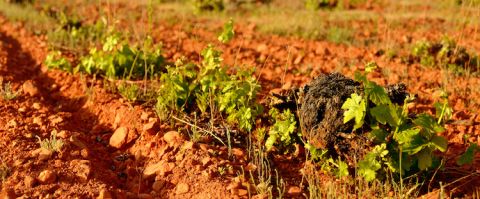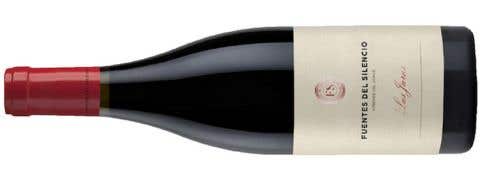From €16.35, $22.50, £19.95
The wines of the week section has always been one of my favourites as a reader and follower of JancisRobinson.com. I think there will be many of you who agree with me. You should know that it is also one of the most fun to write because it allows contributors to be subjective and explain those projects that have touched them on a personal level. In addition, the fact of not having to score the wine gives greater freedom, with no pressure on the taster.
I hereby allow myself to convert the ‘wine of the week’ into a ‘moment of the week’, because I do not want to merely choose a wine, I want to drink it and share it in a situation that is special, and makes me happy.
I would love to meet many more Purple Pagers than I meet and I am sure you would be surprised by my English accent, which sounds extremely Spanish. This long worried me until I saw a movie in which Antonio Banderas spoke in English with an accent not far from mine. That revelation gave me tranquility. While writing for this website I am also worried that I don't have perfect English grammar, especially because I have always valued JancisRobinson.com for its very high literary level. These feelings always assault me when I submit an article and I start to wonder whether my English is getting worse. However, when I review my article on the day it is published, I think: ‘Wow! What a refined English I have!’
What happened to make my perceptions so different between the day I present the article and the one on which it is published? The answer is simple. This is the team of editors that we have. Jancis, Julia and Andrew are like those elves in fairy tales that, without our knowledge, make extraordinary the ordinary. I feel I am very lucky that they take time to review my texts. So why I am telling you all this? Because my ‘moment of the week’ has a lot to do with Andrew Morris (and the Mencía grape).
Andrew has a great capacity for working (Jancis dixit) and a very pleasant soul. He is the ideal co-worker. He takes the time to read my tasting notes with great precision and move the words in such a manner that makes them more understandable and enjoyable to read. Julia, on the other hand, has an extraordinary level of depth and precision. Sometimes, after reading my articles, she sends an email with a list of questions, many raising aspects which had never occurred to me, and which I have no idea how to answer. It's amazing. She has the ability to deepen your article and to make you seem like a writer with much more knowledge than you really have. [I can’t tell you how much I enjoy editing Ferran’s enthusiastic prose – JR]
Andrew lives in Fez and I am lucky that the Fez–Barcelona flight connection is very fast and that, besides, Andrew is in love with my city. That is why some weekends he leaves Morocco to enjoy Spanish wines and tapas. I admire his work and the beautiful friendship we have begun. Therefore, I decided to share with him, on the left in the picture at the top of this article, our ‘moment of the week’.
We took a couple of glasses from Jancis Robinson and Richard Brendon, a bottle of Fuentes del Silencio, Las Jaras 2016 and headed up to one of my favourite nooks in Barcelona. It is a bench under the shade of a banana tree in an area where there are some tourists who contemplate the colourful fountains when they climb the stairs on their way to the MNAC Museum. Luckily for us, the Mies van der Rohe Pavilion, one of my favourite buildings, is just in front of us. It does not usually appear in the tourist guides as a must-see place but I understand and appreciate it.
The monuments of Gaudí, the museums of Miró or Picasso, even the visit to the Camp Nou football stadium, are usually more exciting tourist attractions. But this Mies van der Rohe building, commonly called the German Pavilion, was built on the occasion of the International Exhibition of 1929. It’s a construction of simple lines where less is more. It is salutary to consider what it must have meant at the time it was designed.
We opened our bottle of Fuentes del Silencio, Las Jaras 2016. I decided to share this wine with Andrew because it has been one of the projects that has most profoundly marked me recently. The vineyards are located in the Valle de Jamuz, a remote region to the south-west of the province of León, almost bordering on Zamora, and separated from Galicia by the Sierra del Teleno. The denomination of these wines is the extensive Vino de la Tierra de Castilla y León. Only one of Fuentes del Silencio’s wines, Gandara, qualifies for the DO León because it comes from a single vineyard that is entirely within its boundaries but this is not the case with the rest of the vineyards they own.
The Sierra del Teleno protects this sunny area from the rain and wind that are associated with neighbouring Galicia. Many of these vineyards were abandoned, at least until Miguel Angel Alonso and María José Galera, medical doctors by profession, decided to invest in them and recover them. Their connection with this area derives from Miguel Angel's childhood when his father owned a family home in the town of Herreros de Jamuz, which is where the winery is located.
The two doctors started to buy abandoned plots. It is unsurprising that the people abandoned them because they are some of the most difficult vineyards to work that I have ever seen. The training system is called vaso rastrero, a traditional training system whose bush vines are only just above ground level. Most of the plants are between 50 and 130 years old. In addition, they are all extremely small plots, so that one hectare of vineyards may involve 10 scattered plots. Today they have 30 ha (74 acres) in total of some of Spain’s highest Mencía vines at 850–1,000 m (2,790–3,280 ft) above sea level. In addition, a small percentage of Prieto Picudo (a traditional variety from the region) and Alicante Bouschet may season the blend.
This is a hard, dry region, with extreme contrasts between day and night temperatures. The rocks are rich in quartz and the soil is very poor. Consequently, the yields are ridiculously low, with an average crop level of just 1,000 kg/ha, which is crazy. Although, by improving pruning methods and viticulture, yields are slowly being increased. The first vintage was 2013 and they started to make it in a small garage. Today they have a boutique-style winery which produces about 30,000 bottles a year. Winemakers Marta Ramas and Miguel Fisac are in charge of the technical work.
The spontaneous alcoholic fermentation takes place in wooden vats. For the Jaras bottling that Andrew and I enjoyed, a large proportion of the grapes are destemmed. They try to make a very soft maceration, as if they were preparing an infusion. After the end of fermentation, the wine spends nine months in large wooden 5,000-litre (1,320 gallon) vats. The total production of Jaras 2016 was 15,000 bottles.
I love its herbal character because it is capable of transmitting the wild environment that surrounds the vineyards. Andrew says, ‘it is a vintage with real maturity and roundness on the palate. I like its great depth, but, at the same time, its charge of sweetish fruit’. I was seduced by its tannins, which are fine-grained and accompanied by a lot of flavour, although the texture is all fineness. This is a pretty sweet face of Mencía. Andrew highlights its ‘plum and blackberry aromas, with considerable spice’. This is a wine that opens a conversation with its dynamic movement between herbs, sweet fruit and spices.
It's February, with perfect weather in Barcelona, and we were tasting a great wine. It's a great ‘moment of the week’ that permits me to thank Andrew for being such a fabulous literary elf. The sun sets and we started to talk about how we would like to follow the evolution of this winery and the enormous potential the vineyards have. We have shared consideration of a project with great potential and we have to trust in it. Time will tell.
The wine is currently available in Spain, the US and at Jeroboams in the UK.















